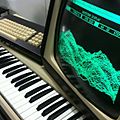Electronic music facts for kids
Electronic music is a type of music created using electronic tools. These tools can be things like synthesizers, computers, or even special tape recorders. Artists use them to make unique sounds and rhythms.
After World War II, tape recorders became popular. Composers started using them to make new kinds of music. They would combine many different sounds. Sometimes they used sounds from regular musical instruments, but changed them with the tape recorder.
Other times, they recorded sounds from everyday life. This included sounds like water, traffic noise, or bird song. These noises were then put together using the tape recorder. Tapes were often cut into pieces and then "spliced" (put back together) in a new order. This created very interesting results.
Some people wondered if these new sounds were truly "music." Others found it boring to watch a tape recorder during a concert instead of live musicians.
Composers in Paris began experimenting with electronic music in the 1940s. They called their work “Musique concrète.” This name came from using natural, "concrete" sounds. "Concrete" meant the opposite of "abstract" music, which was written down.
These sounds were played at different speeds or combined in many ways. They could be played backwards or repeated in a "loop." Composers also used mixers and re-recorded sounds onto other tapes. They could also filter sounds or add effects like vibrato or echo. Later, they used synthesizers, which are machines that make electronic music in real time. Synthesizers often sounded more like normal instruments.
Computers have also been used a lot for making electronic music.
Contents
Electronic Music in Classical Styles
Many famous composers have used electronic methods to create music. Some of these include John Cage (1912-1992), Bruno Maderna (1920-1973), and Karlheinz Stockhausen (born 1928). Often, these composers mixed electronic sounds with regular instruments. This created a blend of old and new sounds.
Electronic Music in Popular Styles
In popular music, electronic sounds started to appear in the 1960s. Producer Joe Meek and inventor Bob Moog helped expand the sounds used in pop music. By the end of the 1960s, electronics were widely accepted in the music industry.
In the 1970s, artists like Giorgio Moroder, Jean-Michel Jarre, Brian Eno, and Kraftwerk made electronic music very famous. Their unique sounds changed how pop music was made.
By the early 1980s, electronic music became very popular. Bands such as New Order, The Human League, Pet Shop Boys, and Depeche Mode became well-known. These bands sometimes mixed electronic music with rock music.
Today, in the 21st Century, electronics are a huge part of popular music. It is no longer strange to use electronic tools. In fact, many artists use only electronic equipment to create their music.
Electronic Dance Music (EDM)
A very popular type of electronic music is electronic dance music, or EDM. EDM is usually made for dancing. This means it is often played in clubs and is usually fast-paced.
While many electronic music styles are also EDM, not all electronic music falls into this specific group. Some examples of EDM styles include house, techno, trance, and dubstep.
In 2018, a report showed how much the electronic dance music market had grown. It grew by 12 percent in just one year. YouTube was a big reason for this growth, helping many people discover EDM.
Images for kids
-
Front page of Scientific American in 1907, showing the Telharmonium
-
Leon Theremin demonstrating the theremin in 1927
-
CSIRAC, Australia's first digital computer, displayed at the Melbourne Museum
-
Early electronic organ: Yamaha Electone D-1 (1959)
-
Early drum machine: Korg Donca Matic DA-20 (1963)
-
Keith Emerson performing in Saint Petersburg in 2008
-
Yamaha DX7, a model for many digital synthesizers of the 1980s
See also
 In Spanish: Música electrónica para niños
In Spanish: Música electrónica para niños

















